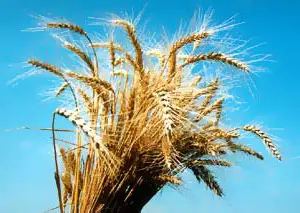 Wheat
WheatAutumn has come and gone… What should you do in the garden to ensure a good harvest next year? First and foremost, it’s essential to create conditions that allow trees to absorb the necessary nutrients and moisture until the frost sets in. After harvesting, fruit trees begin to form flower buds for the following year’s crop, so it’s crucial to act quickly.
Immediately after the harvest, you should till the soil in the garden to a depth of 7-8 inches (18-20 cm), and under the tree canopies, till to a depth of 4-5 inches (10-12 cm). To avoid damaging the roots, use the edge of the spade near the trunk. Autumn tilling improves the physical, chemical, and biological processes in the soil, helps accumulate nutrients, eliminates harmful insects, and retains moisture during the fall and winter months. Additionally, loose soil better protects the root system from freezing.
Before tilling, it’s also important to add the right amount of organic and mineral fertilizers. Depending on the soil and climate conditions, as well as the type and age of the trees, the following approximate fertilizer norms are recommended. In the Polesie and Forest-Steppe regions, for a fruit-bearing tree aged 10-12 years, apply 308-396 pounds (1.4 – 1.8 centners) of manure, 4 ounces (1.8 kg) of superphosphate, and 1.1-1.3 ounces (500-600 g) of potassium salt. Nitrogen fertilizers (ammonium nitrate) should be applied in the spring at a rate of 2-3 ounces (0.9-1.3 kg). Manure is applied every two years, while mineral fertilizers are applied annually. As trees age, the amount of fertilizer increases. In collective gardens, fertilizers should be applied in ring-shaped trenches dug to a depth of 6-7 inches (15-18 cm).
Special attention should be paid to the care of the tree trunk in the fall. It should be cleaned of old, dead bark and coated with a mixture of lime and clay. Dead bark restricts air access to the living cells of the wood, provides shelter for pests, and creates conditions for fungal diseases. Coating the trunks with lime protects them from sunburn and frost. Once the leaves have fallen, it’s beneficial to spray the trees with urea (about 1.1 pounds or 500 g per 26 gallons or 100 liters of water) to protect against pests and disease pathogens. In a dry autumn, be sure to water the trees thoroughly to moisten the soil to a depth of at least 31-39 inches (80-100 cm). This significantly increases the trees’ frost resistance.
For berry bushes, the following tasks should be performed: in areas with fruit-bearing strawberries, fertilize and till the inter-row spaces. For every 0.25 acres (100 hectares), apply 308-396 pounds (1.5 – 2 centners) of compost, 4-6 ounces (2-3 kg) of superphosphate, and about 2.2 ounces (1 kg) of potassium salt. Nitrogen fertilizers (ammonium nitrate) should be applied in the spring at a rate of 2.2-3.3 pounds (1-1.5 kg). Fertilizers should be spread in the inter-row spaces and around the bushes, then immediately raked into the soil.
Bush berries—black currants, red currants, gooseberries, and raspberries—should be systematically fertilized to ensure proper growth and good yields. Every two to three years, apply manure or compost around the bushes: 13-18 pounds (6-8 kg) or a complete mineral fertilizer consisting of 2-3 ounces (60-80 g) of superphosphate, 0.7-1 ounce (20-30 g) of potassium salt, and 1 ounce (30 g) of ammonium nitrate. When applying organic and mineral fertilizers simultaneously, reduce the amount by half.
Till the soil in the inter-row spaces of berry bushes to a depth of 6-7 inches (15-18 cm), and around the bushes to a depth of 5-6 inches (12-15 cm). Black currants and red currants yield well for about six years, while gooseberries for about seven years. Therefore, in the fall, cut back older branches at the base. For raspberry bushes, remove all the canes that have already borne fruit. New plantings of bush berries should be done in the fall. After planting, trim the top to about 7-8 inches (18-20 cm) above the ground to promote better rooting and growth.
